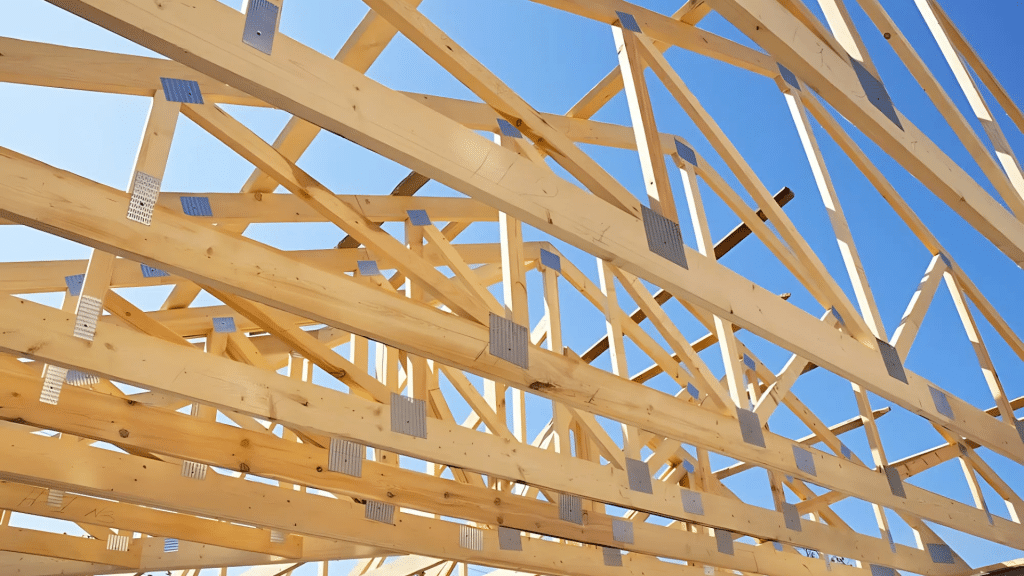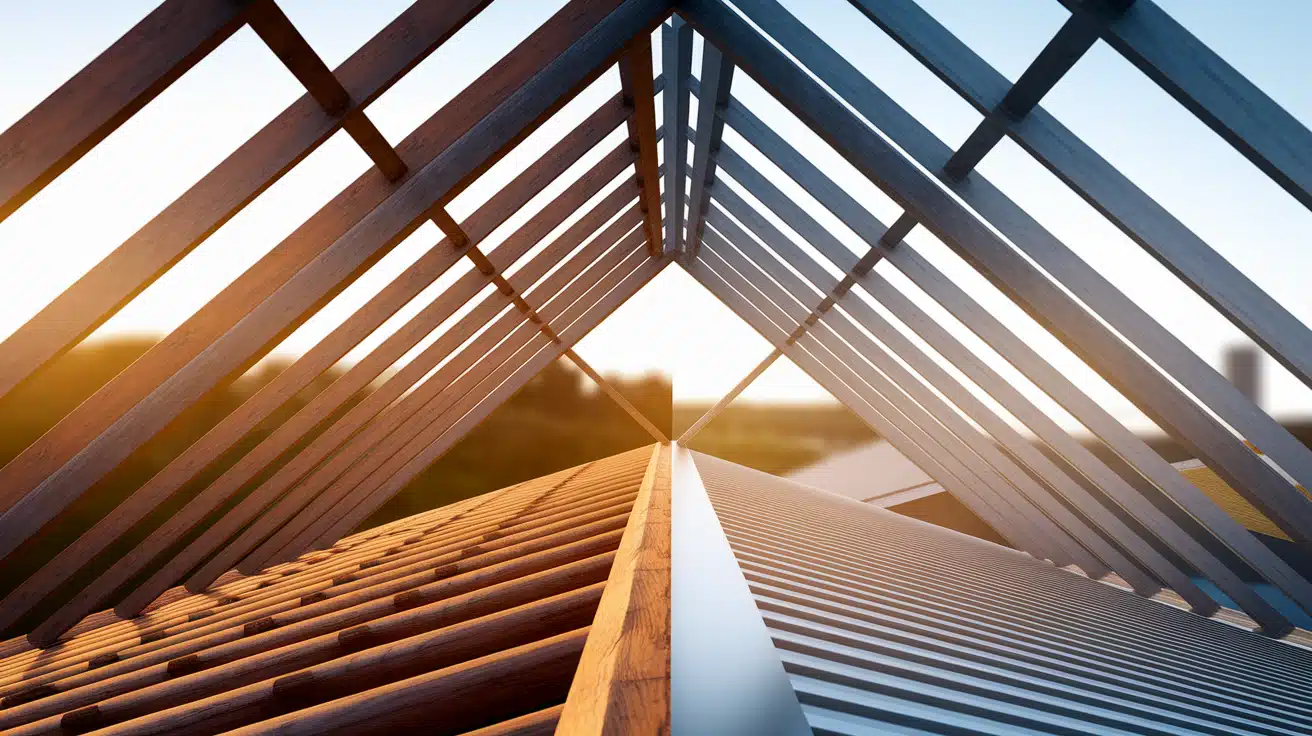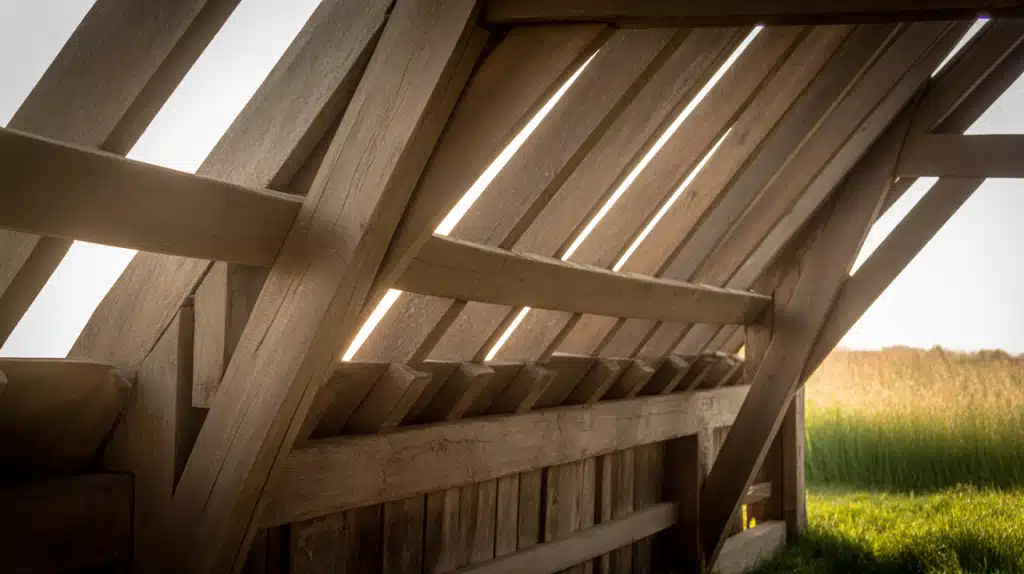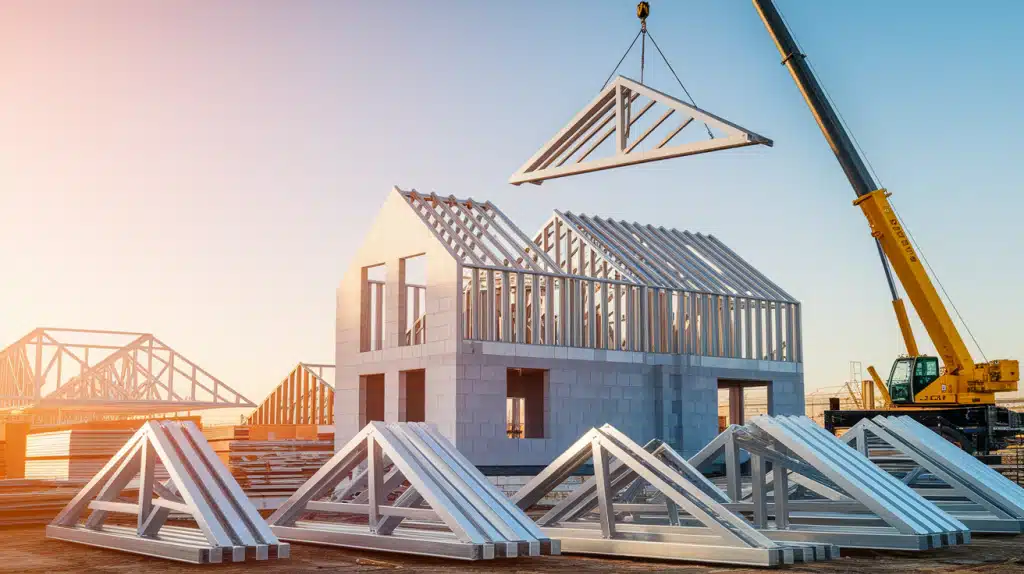The roofing system plays a crucial role in building or renovating a home, significantly affecting the project’s timeline, budget, durability, and overall design.
Rafters are traditional, hand-cut beams assembled on-site, often favored in custom homes for their flexibility and the open attic space they provide.
Trusses, in contrast, are factory-built triangular units engineered for speed, strength, and cost efficiency. They are a staple in most modern builds.
This guide simplifies the decision by breaking down the key differences, pros, and cons, as well as use cases, so you can choose the proper structure to match your goals and your home’s style.
What Are Rafters? A Look at Traditional Roof Framing
Rafters are individual sloped beams that run from the ridge beam at the peak of the roof down to the exterior walls.
Together, they form the basic skeleton of a pitched roof, supporting the roof decking, underlayment, and final roofing material.
Rafters are a time-tested method of roof framing, commonly referred to as “stick framing” because they are assembled piece by piece on-site.
How Rafters Are Built and Installed
Rafters are usually made from dimensional lumber (like 2x8s or 2x10s) and are cut and assembled on-site by skilled carpenters. This process allows for custom angles and lengths, which is ideal for complex or one-of-a-kind rooflines.
Here’s a basic look at the process:
- The ridge board is installed at the roof’s peak.
- Rafters are then measured, cut, and attached at an angle from the ridge to the wall plate.
- Collar ties, ceiling joists, and other bracing components are added for strength and stability.
- Finally, the roof decking is laid over the rafters to create a solid surface for roofing materials.
Best Use Cases for Rafters
Rafter framing shines in scenarios where flexibility and customization are key:
- Custom homes or remodels with unique roof designs
- Homes aiming for open attic spaces, cathedral ceilings, or loft areas
- Projects where on-site adjustments may be necessary due to irregular layouts or renovation constraints
- Areas with skilled labor readily available and where longer build times are acceptable.
What Are Trusses? The Prefab Powerhouse
Trusses are pre-engineered triangular frameworks made from wood or metal. They are designed to carry the load of the roof while evenly distributing weight across the walls of a structure.
Unlike rafters, trusses combine multiple smaller pieces connected with metal plates to form a strong, rigid unit.
Each truss acts as a self-supporting component of the roof, eliminating the need for interior load-bearing walls in many cases.
Their interlocking triangular geometry creates stability through tension and compression, making them both lightweight and incredibly strong.
How Trusses Are Manufactured and Used
Trusses are built off-site in specialized manufacturing facilities, where they are cut, assembled, and pressed into shape using computer-aided design (CAD) systems.
The installation process is fast and efficient:
- A crane or lift places each truss on the structure’s top plate.
- Trusses are spaced according to engineered specs, typically 24 inches on center.
- Workers secure the trusses, apply bracing for stability, and add sheathing on top.
Because they are made in a controlled environment, trusses also offer consistent quality and fewer on-site errors.
Where Trusses Shine the Most
Trusses are ideal for projects where efficiency, speed, and cost control are top priorities:
- Production homes and large-scale developments where time and budget are critical
- Projects with straightforward rooflines that don’t require complex customization
- Remote builds or locations with limited skilled labor, as they are easier and faster to install
- Roof systems that don’t require attic space, since the internal webbing of trusses limits usable upper areas.
Rafters vs Trusses: What’s the Big Difference?
Here’s a clear side-by-side comparison to help you quickly grasp how rafters and trusses differ in key areas:
| Feature | Rafters | Trusses |
|---|---|---|
| Cost | Higher labor costs due to on-site cutting | More budget-friendly overall due to mass production |
| Build Time | Longer requires skilled labor and customization | Faster arrives ready to install |
| Strength | Strong, but depends on craftsmanship | Engineered for maximum strength and load-bearing |
| Customization | Highly customizable for unique roof designs | Limited customization; best for simple layouts |
| Attic Space | More open space for storage or living areas | Limited space due to webbing |
| Installation Location | Built and assembled on-site | Factory-built, then installed on-site |
| Design Precision | Manual measurements and cuts | CAD precision in design and fabrication |
| Best For | Custom homes, open ceilings, renovations | New builds, standard designs, cost-conscious builds |
Visual Spacing and Load Distribution
- Rafters are spaced farther apart (typically 16″ to 24″ on center) and transfer roof loads more directly down through exterior walls.
- Trusses utilize interconnected triangles with webs that distribute the load more evenly, enabling longer spans without the need for interior supports.
On-Site Labor vs. Factory-Built
- Rafters require skilled carpenters to measure, cut, and install each beam by hand. This offers flexibility but demands more time and expertise.
- Trusses are pre-made in a factory, then delivered and installed in a fraction of the time, making them ideal for speed-focused builds with consistent quality.
Pros and Cons of Rafters vs. Trusses
Here’s a quick glance table to help you weigh the benefits and trade-offs of rafters and trusses:
| Feature | Rafters (Old-School Strength) | Trusses (Prefab Powerhouse) |
|---|---|---|
| Pros | – Highly customizable for complex rooflines | – Fast and easy to install |
| – Allows for open attics or vaulted ceilings | – More affordable overall | |
| – Classic look with exposed beams is possible | – Engineered strength and load distribution | |
| Cons | – Requires skilled on-site labor | – Not ideal for usable attic space |
| – Longer construction timelines | – Difficult to modify once installed | |
| – Generally more expensive due to labor and time | – Less flexible for creative or one-off designs |
This side-by-side comparison highlights the custom craftsmanship of rafters versus the efficient engineering of trusses, helping you decide based on your project goals, budget, and build style.
When Should You Choose Rafters Over Trusses?

Rafters are the go-to choice when your project demands flexibility, craftsmanship, and creative control.
They’re especially well-suited for custom homes with unique rooflines, irregular shapes, or architectural flair that standard framing can’t easily accommodate.
If your design includes open attic space, vaulted ceilings, or exposed beams for aesthetic appeal, rafters provide the structure and freedom to make it happen.
They also work well for renovations and additions, where the framing needs to be adjusted to fit an existing structure with precision and care.
Considerations Before Choosing Rafters:
- Time: Stick framing takes longer due to on-site measuring and cutting
- Climate: In areas with stable weather, longer build times may not be a risk, while in rainy or snowy regions, it could lead to delays
- Contractor Availability: Rafters require skilled carpenters, which may not be available everywhere or within your timeline
Considerations Before Choosing Trusses
- Project Scale: The larger the project, the more cost-effective trusses become
- Design Limits: Trusses may restrict roof shapes and usable attic space
- Load Needs: Trusses are engineered for strength, making them suitable for snow loads, long spans, and structural uniformity
Conclusion
Rafters and trusses each bring unique strengths to the table. Rafters offer flexibility, an open attic space, and a handcrafted feel, making them ideal for custom designs.
Trusses, on the other hand, are cost-effective, faster to install, and engineered for consistent strength, perfect for standard or large-scale projects.
If you value customization or efficiency, understanding these differences can help you make a confident, informed decision.
Have you used rafters or trusses in your project? Or are you still deciding? Drop a comment below and share your thoughts or questions. We’d love to hear from you!




